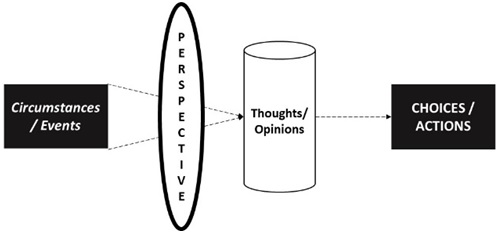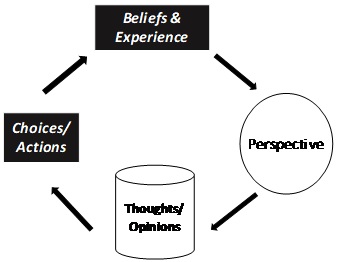
A Coaching Power Tool Created by Thomas Varghese
(Executive Coach, INDIA)
Is the glass half empty or half full?
It is very common to have heard this famous idiom which is rhetorically used to invite optimism –to believe that the glass is half full rather than half empty. It can be a precise analogy for reframing perspectives, a deeper analysis of which could decode ‘Perspectives’ and the way to ‘Reframe’ them.
What is perspective and how it is formed?
Perspective can be defined as your viewpoint or way of regarding something. It is imperative to have a clear understanding of ‘Perspectives’before dealing with reframing:
While the analogy of half-filled glass undoubtedly motivates us to be positive, it isn’t completely true. What is true is that the glass is neither half full nor half empty, it is filled with half water and half air. Although we are aware of this fact, we never talk about it. That is the power of perspective.
‘Perspective’, although a controllable variable, can dominate the uncontrollable reality, as it defines the way you feel about your circumstance, shaping your thoughts and opinions, that further lead to choices and actions.

Fig.1 Perspective leads to action
It is therefore important to have the right perspective – a perspective that empowers you to move forward rather than a disempowering perspective.
A disempowering perspective
What is a disempowering perspective? As the name suggests, it is one that either restricts you to see the complete picture or misleads you to negative conclusions or unhappy situations. It is like wearing the tinted lens on a beautiful day, which makes the day appear dull when it is actually bright. Over time, you actually believe that the World is of the colour of your tinted glass.
Disempowered perspective could be broadly due to (among other things):
A disempowering perspective is even more dangerous when it is misleading. While empowered perspective could help a person overcome his failures, a misleading disempowering perspective can destroy even a successful person.
Recently, an interesting article captioned “Why is it better to come third rather than a second” caught my attention. The article talks of young Jamie Henthorn who was a talented, fast and dominating sprinter who took to gruelling training and made giant leaps in the junior athletic championships at a young age. When he finally got a chance to represent Hungary in European Athletics Championship, he closely missed Gold Medal to Dwain Anthony from Britain, despite finishing the 100m sprint in the same time, and had to settle for Silver Medal. Angelos Pavlakakis from Greece won the Bronze Medal in the same race. Today, interestingly, you would find a Wikipedia page for both Dwain (who made it to top) and Angelos (who one third) but not any of Jamie. The article quotes an interesting observation that Silver medallist sees themselves as the first loser while bronze medallist sees themselves as the last winner!
The first loser perception is a startling testimony of how disempowering perspective can be destructive despite being talented and successful. One should, therefore, be continuously conscious of any disempowering or unhelpful views and work towards reframing them.
Empowering Perspective
I have not failed. I’ve just found 10,000 ways that don’t work – Thomas Edison.
Contrast to the story of Jamie is that of Edison’s. Despite repeated failures, he constantly gathered courage and tried until he succeeded in inventing the bulb. If not for Edison’s sheer empowering perspective over failures, the world wouldn’t have seen the light today.
One needs to constantly adopt empowering perspective despite challenging times and circumstances which enable you to see the brighter side of things and navigate forward.
I can recollect my own example of reframing perspectives during one of my professional stints. I was asked by my manager to sell a concept of charging more for an intermediate product as opposed to a finished product (which is not only unusual but also unacceptable). I was initially taken aback at this request as I felt it was an impossible request.
However, my manager gave me a few ideas on how this could be attempted from his deep experience. After the conversation, I realised I was initially not open to the idea biased by my own experience. However, when my manager put things into perspective, I took up the challenge. When I actually pitched the idea before the President of leading Textile Company in India in the most persuasive manner, it did work. Given the overall demand-supply situation in the Industry, my request was finally accepted.
To me, this is a classic case of reframing my own perspective and attempting something which I had considered impossible. With a cogent argument backed with some facts, he was able to change my perspective on what I almost concluded as impossible.
Reframing disempowering perspectives
Each one of us has our own perspectives about our world and the circumstances we find ourselves in. Perspectives are not all right or wrong, but they definitely have the power to take us forward.
When you feel as though you can’t make a breakthrough, or achieve a goal, or solve a challenging problem, or mend a relation, it is worth spending some time exploring your perspectives on the issue.
Once you acknowledge that you have a disempowering perspective, all that you need to do is to reframe it. Yes, it is not all that easy as said, but a few simple techniques may help:
- Consciously Distinguish – The first step to master the art of reframing perspective is to consciously distinguish it from circumstances and identify the disempowering ones. We should always recognize that perspectives can be changed and widened.
- Holistic approach – A viewpoint in physical terms is generally a spot where you get a maximum sight of the whole place. Similarly, your perspective should also be based on a holistic view. You should always obtain as much information/ knowledge as possible before framing a perspective. Try to zoom out of the immediate circumstance to have a broader perspective.
- Empathy – Although the perspective is very personal, it may have something to do with people around us, or we may have a perspective about people themselves. Having empathy for others and their circumstance will not only enable you to appreciate their point of view but also widen your horizons about different issues.
- Being neutral – It is natural to come up with better solutions for others’ problems than our own! This is because we assess the situation better from a neutral position with little emotional baggage. A similar approach would help in having a balanced perspective.
- De-Stress – A perspective may be momentary, especially when you feel low about certain things. There is a risk of having a disempowering perspective not for the circumstance but for the immediate state of mind. Allowing your mind to de-stress could be a simple solution to avoid this. It is not uncommon to be positive after listening to favourite music, playing a sport or reading a book, which helps you shrug away the momentary negativity.
- Travel – Going to new places and meeting new people can provoke you to think beyond your boundaries and you can try to bring uniqueness to your perspectives. I personally love the Bollywood film Zindagi Na Milegi Doobara where a vacation to Spain turns into an opportunity to mend fences, heal wounds, fall in love with life and combat their worst fears.
It is also important to note that perspectives not only lead to action but may have been caused by past action, making it a vicious cycle. Eventually, your set of thoughts and opinions shape your attitude and personality.

Fig.2 Past actions lead to Perspective
You may have noted that Figure 1 and 2 consist of the same objects. However, mere rearrangement of the same enables us to see them differently. A simple example of how reframing perspective!
Reframing perspective isn’t, therefore, a one-time exercise but is a conscious effort towards self-discovery and acknowledging the presence of other perspectives, enabling us not just to achieve our goals but to find our light within.
Self Application
One can ask themselves the following questions to understand the power of perspective:
- Recollect two of your own experiences – one which you feel very good about and the other that you regret.
- Identify alternate ways of looking from a neutral view.
- For your positive experience, could it have been better? How did you find your satisfaction?
- Negative experience – is there anything you learnt from it?
- If you could find alternate perspectives now, why couldn’t you find them earlier? – Try to assess the reasons – these may help you clear your underlying beliefs and biases.
Eventually, when we see the distinction, it will enable us to decide how our thoughts are built. The more aware we are of our own perspectives, the more empowered we become.
Coaching Application
It is possible to discern and re-frame perspectives ourselves. However, as an objective observer, a coach is in a unique position to help identify unhelpful perspectives and to support clients to re-frame them.
As coaches, we need to actively listen to the client to identify any kind of disempowering perspectives. Instead of being judgemental, the coach should help the client understand why a particular perspective is unhelpful. Using own examples or relatable success stories could help inspire clients to wear a positive lens.
Re-framing is an art and when done effectively, it can change a client’s life in an instant. Sometimes it can be as simple as asking the client to pause for a moment to reflect on what they’ve said, and what perspective it might indicate
Here are some powerful questions you could use to help someone discern and reframe their perspective:
Reflection
-
- How often do you feel that the problem lies in perspective than the issue itself?
- When have you experienced a change in your perspective? What did it take for you to change your point of view?
- How will you make your clients discern their unhelpful perspectives? How will you then support to re-frame them?
- What do you think mastering re-framing means? What would be possible if you become a master at re-framing?
- How would you do this?
- How would you get your clients to do this?
Reference:
International Coach Academy paper on Power Tools